Event: David John Marotta v. Edward Teller
Site: Party
Date: 1977-07-09
Round: 1
White: David John Marotta
Black: Edward Teller
Result: 1-0
I wrote an article on the economic lessons I learned from playing chess. In that article I mentioned a first and second game played against Edward Teller. From early on I recorded every chess game I played for later analysis. This is one of the lessons I learned from chess. Realistically analyze your moves after you make them. Investors tend to only remember the times when their advice was brilliant and rate their ability to time the markets more highly than they should. I record every idea or thought with a specific date and current value of a stock or the markets. Then six months later I can look to see if my thought was a good idea. This is one of the reasons I say that investing is like playing chess in slow motion.
One of the by-products of recording every chess game I play is that I have two of Edward Teller’s chess games recorded. His biographies always mention that he was a consummate chess player, learning at the age of six and beating his father three or four years later. But as far as I know, no other recorded games of his play exist.
This was the second game at a social party where theoretical physicist Edward Teller invited me to play chess with him. I was 16 years old, but had been playing tournament chess for several years. Teller was 69 and had been playing regularly since he was six.
In the first game Teller played white, assumed that he could beat a youngster like me, came out with a quick attack and lost beating on a defense that held strong. I imagine that for nearly everyone Teller played, he could win quickly and decisively with an aggressive attack.
In this second game I played White and decided that Teller would probably play the same way. I did not want to play aggressively myself, even though playing White that is usually the best course of action, as I knew Teller was an excellent player. So I decided to play an opening which I knew well, but which looks crazy to a seasoned player. My hope was that it would would encourage him to think that attacking recklessly was not so reckless.
1. b4 …
Polish opening.
Moving your queen knight’s pawn two squares is called the “Polish opening” not as a complement. It is considered a crazy move even when it is played by an excellent chess player. It gives the tempo of the game too much to Black.
1… e5
2. Bb2 Bxb4
Teller takes my queen knight pawn and develops his bishop at the same time. My next move is to take his king pawn but expose my bishop where it will probably need to retreat again. Teller’s pawn in the center is worth more than my pawn on the side so I’ve gained every so slighly, but it is at the expense of giving more of the Tempo and control to Teller. I was hoping that Teller would use it to attack recklessly again.
3. Bxe5 Nf6
4. a3 Ba5
5. e3 d6
Driving my exposed bishop back.
6. Bb2 Nc6
Teller now has three pieces developed, but my central pawns are intact.
7. Be2 O-O
8. Nf3 Be6
9. O-O Re8
10. c4 Bg4
Both sides playing cautiously has resulted in equality. 10. … d5 11. cxd5 Nxd5 12. Qc2 Qd7 is an alternate line of play.
11. Nc3 …
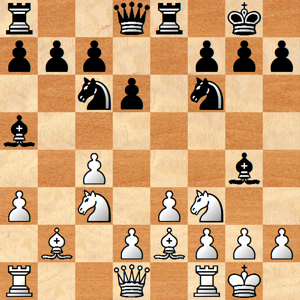
Teller has played much more carefully, either because he lost the first game or because he is playing black and was waiting to build his pieces into a position where he could attack. Notice that both of Teller’s bishops are positioned against white’s knights whereas both of white’s bishops are defensively arranged protecting those knights.
Generally a knight and a bishop are each worth about three pawns. But a bishop is worth ever so slightly more than a knight toward the end of the game. Bobby Fischer considered a bishop to be worth 3.25 pawns and a Knight only 3 pawns. But bishops are only worth more when the board is open and they can move about. Both of my bishops only have one square to roam. Leaving my bishops where they are is probably Teller’s best course of action.
11. … Bxf3
Black’s Queen bishop is worth more than white’s King knight. Better would be to exchange the other bishop in 11. … Bxc3 12. Bxc3 Ne4 13. Bb2 Ne5.
12. Bxf3 Ne5
13. Be2 c6
14. d4 Bxc3
15. Bxc3
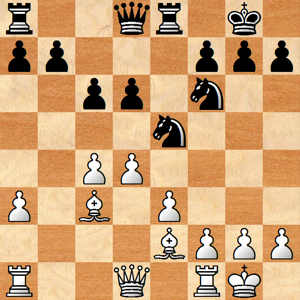
Now Teller has exchanged both of his bishops for both of my knights. Since the game is opening up, my bishops now control a significantly greater number of squares than they did trapped behind my knights. And my pawn structure in the center of the board is slightly stronger than Teller’s king rook on the open file.
15. … Ne4
Preferable is 15. Ng6.
Teller loves to complicate positions. He leaves his knight on e5 in danger of being taken by my pawn to attack my bishop with his other knight. The exchange would give him a slight positional advantage so I ignored it.
16. Bb4 Ng6
17. Bd3 a5
Preferable is 17 … c5
18. Bd2
Preferable is 18. Be1.
18… Qg5
19. Bxe4 Rxe4
20. f3
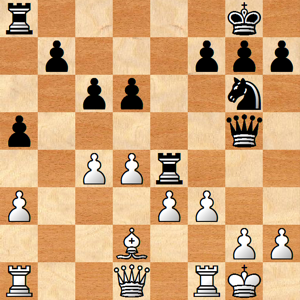
At this point my central pawn defense is intact. I am attacking Teller’s rook, and when it retreats I will push my king pawn to where his rook had been uncovering an attack on Teller’s queen by my bishop. After his queen retreats the tempo of the game will be in my favor. My pawns will mostly be on white squares while my bishop is on a black square. This is as favorable a structure as you can have in chess.
Teller sees all this and decides that my pawn structure and my bishop need to be removed from the equation. He can, by the line of play he takes, break up my central pawn structure and take my bishop if he sacrifices his rook. Giving up a rook (usually worth 5 pawns) for a bishop (3 pawns) and a pawn leaves Teller a pawn down for the exchange. Teller believes that the ensuing attack is worth giving up a pawn of material. But I’ve analyzed the board, the attack just isn’t there with careful defensive play by white.
Even at 16 I was a good defensive player. During my previous seven years of tournament play I practiced sitting on my hands to avoid moving too quickly and asked four questions before making every move: What did my opponent do? What can he or she do? What can I do? What should I do?
I still use more sophisticated versions of those four questions in every major decision. They have a brilliance that helped me as a youngster of separating the past (What did my opponent do?) from the future (What can he or she do?). Since things do not move in a straight line, the past does not usually continue indefinitely forever. You can’t drive by only looking in the rear view mirrow.
Similarly until you have analyzed all the possible options (What can I do?) you should not make your selection (What should I do?). Too often investors choose between two poor options without knowing all of their choices. And when investors have too many options, sometimes they refuse to make a decision, which is by default a decision for the status quo even if several options are better than the status quo. Chess is a timed game. There is plenty of time for analysis, but ultimately a decision must be made. Chess helped me build the decision making practice of adequate analysis and then action.
21. … Rxe3
Teller presses an attack which isn’t there. Better is 20. … Re7 or Ree8.
21. Bxe3
Stealthier would be to leave the pinned rook hanging and play 21. Rb1 or Rf2.
21… Qxe3+
22. Kh1
Better to develop the rook with 22. Rf2.
22… Nf4
23. Ra2
Alternately, 23. g3 or Rb1.
23… Re8
Better might be 23. … Qc3 24. g3 Ng6 25. Qb1 Qxc4.
24. Qd2 Ne2
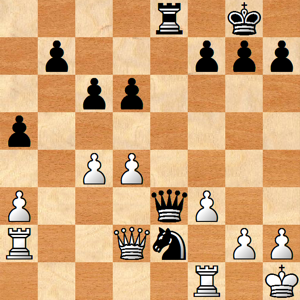
My defenses have held but the complexity of the position means that I risk losing a pawn or getting two pieces forked by Teller’s knight. If I can exchange pieces evenly I have a won position since I am a pawn ahead. Therefore I work to exchange as many pieces as possible to simplify the board to a win for me.
In the next eight moves 24 pawns worth of material will be exchanged and leave the board (two queens and six pawns).
25. Qxe3 Rxe3
26. Rd2 Nf4
27. g3 Ne6
28. d5
Better might be 28. … Rb1 29. Rxf3 Rxb7 30. g6 Rd7.
28… cxd5
29. Rxd5 Rxa3
30. Rxd6 Rc3
31. Rb6
Better would be 31. Ra1.
31… Rxc4
32. Rxb7 g6

Twenty-four pawns worth of material has been removed from the board in the last eight moves. The game is now more clearly in white’s favor. Black can try to press his lone rook pawn toward queening at the end of the board but there isn’t a winning line of play without white making a mistake. Alternately Black can try to take some of white’s pawns as a winning strategy.
33. Ra1 a4
34. Ra7 Nc5
35. Ra2 Kg7
36. Kg2 Kf6
37. Kf2
A better line is 37. Rc7 h6 38. Rb2 Ke6 39. Re2+ Kd5 40. Rxf7 Rb4 41. Ra7.
37… Rc3
38. Ke2 h5
39. f4
A slight error as Black best responds with 39. … h4 40. gxh4 Rh3 41. Kd1 Rxh4.
39… Ke6
40. Ra5 Kd6
41. Kd2 Rd3+
42. Kc2 Re3
43. Rb2 Re2+
44. Kb1
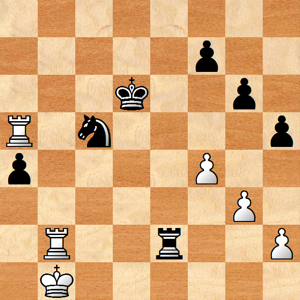
Teller can’t afford to exchange any more material, but can’t find a winning strategy.
Black can’t afford to exchange rooks. Better is 44. … Re1+ 45. Ka2 Nb3 46. Ra6+ Kc5 47. Ka3.
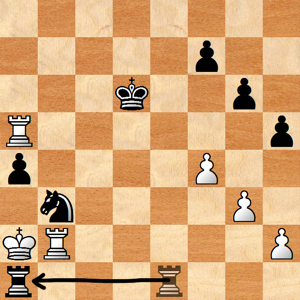
This is an interesting line of play. I think Teller would have taken this line of play if he had seen it. The position shown is after 45. … Nb3
Black (Teller) would be threatening rook to a1 checkmate. But it would be tempting for white (me) in their haste to take material to simply play rook takes pawn. This looks like it avoids the checkmate (which it does) but only at the high price of giving up the exchange of a rook for a knight bringing Black back into material parity. The best play for white is listed above: 46. Ra6+ Kc5 47. Ka3 but it is interesting to explore this line of play to see where it would have gone.
In this line of play black wins white’s rook outright (44. Kb1 Re1+ 45. Ka2 Nb3 46. Rxa4 Nc1+ 47. Ka3 Re3+ 48. Kb4 Nd3+ 49. Kc3 Nc5+ 50. Kb4 Re4+ 51. Kb5 Nxa4). White’s mistake here is 47. Ka3 which looks like the obvious move unless you are looking several moves ahead.
A better move would be 47. Ka1 which still results in the loss of material and position for white (44. Kb1 Re1+ 45. Ka2 Nb3 46. Rxa4 Nc1+ 47. Ka1 Ne2+ 48. Ka2 Nc3+ 49. Kb3 Nxa4 50. Kxa4 h4). If you are a chess player, play these lines of play out as they are fascinating.
The line of play 48. Rb1 also loses for white (44. Kb1 Re1+ 45. Ka2 Nb3 46. Rxa4 Nc1+ 47. Ka1 Ne2+ 48. Rb1 Rxb1+ 49. Kxb1 Nc3+ 50. Kc1 Nxa4)
All of these lines are avoidable by white refusing to take the pawn with 44. … Re1+ 45. Ka2 Nb3 46. Ra6+ Kc5 47. Ka3. But the temptation to take the pawn without analyzing the board exhaustively would have probably been overwhelming. One of the lessons of chess is that even with perfect knowledge something that looks like the right move might not be. You have to look several moves ahead along multiple possible lines of play to successfully analyze a situation and find the best move. If there is a move which is good enough to win, a simpler situation may involve less unknown unknowns (or as they are called in the financial world, black swans).
But back to the game which actually happened. Teller makes the mistake of reducing the complexity on the board, a choice of action which favors white’s superior material.
46. … Rxb2+
45. Kxb2 Kc6
46. Kc3 Kb6
47. Ra8 Kb5
48. Rb8+ Ka5
49. Kc4 Nb3
50. Ra8+
Black Resigns.
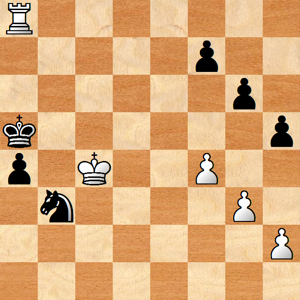
0 – 1
Here is a link back to the first game where Teller played the white pieces.
2 Responses
Geral Long
David
I never played chess until now, age 64. As a result, my 6 year old grandson routinely beats me. That says something for his teacher. Anyway, I’m curious as to your shorthand script for chess moves. Might you give me a source for your shorthand, please.
David John Marotta
When I played chess I used what is called “Descriptive Chess Notation.” For example: P-QN4 is read “Pawn to Queen Knight Four.” This means I am moving a pawn to the fourth square in front of where my Queen’s Knight Started. In descriptive notation the square count always starts from the side making the move. If white plays P-K4 and then black plays P-K4 those are two different squares counting from each respective side of the board. This was the system used for hundreds of years.
More recently, chess books and programs have moved to the algebraic system of chess notation. Think metric. Squares are referenced by letters representing the columns from left to right if you are playing white (a through h) and numbers representing the row from white toward black (1 through 8).
The piece moving is mentioned first, although it is omitted if the piece moving is a pawn, and then the square it is moving to. So the move b4 means that a pawn is moving to the second column fourth row. The board makes it clear that only one pawn (starting on b2) can move to that square.
You can read more about this system of chess notation at http://en.wikipedia.org/wiki/Algebraic_notation_%28chess%29